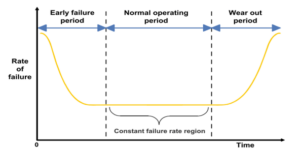RAM ENGINEERING
 RAM refers to the reliability (The probability that an item will perform a required function for a stated period of time),availability(The proportion of time that an item is capable of operating to specification within a large time interval),maintanability(The probability that a failed product will be restored to operational effectiveness within a given period of time when the repair action is performed in accordance with prescribed procedures).
RAM refers to the reliability (The probability that an item will perform a required function for a stated period of time),availability(The proportion of time that an item is capable of operating to specification within a large time interval),maintanability(The probability that a failed product will be restored to operational effectiveness within a given period of time when the repair action is performed in accordance with prescribed procedures).
Intellex Consulting Services (UK) Ltd ensures that all RAM activities are strictly practiced as per the CENELEC standards to ensure world-class quality .
Objective of RAM Engineering
To ensure that the assets delivered into the railway do perform as designed reliably which ensure safety to passengers/staff as well as provide economical returns for the investment.The main objective of RAM is to reduce the overall lifecycle cost(that includes maintenance cost,operation cost,production cost etc.) and increase the system productivity.
 Assets failure rate profile follows a curve popularly called ‘BATH TUB’ curve representing the increased failure rate during the wear in period of new assets , steady state failure rate throughout its design life and finally increasing failure rate during the wear out period at which point the assets require replacement/upgrade.
Assets failure rate profile follows a curve popularly called ‘BATH TUB’ curve representing the increased failure rate during the wear in period of new assets , steady state failure rate throughout its design life and finally increasing failure rate during the wear out period at which point the assets require replacement/upgrade.Intellex provide a web-based tool called Asset Optima-"Project FRACAS" to support RAMS demonstration during Defect liability period -Post commissioning of a project.
Asset Optima identify and resolve systematic failures as well as mitigate wear-in failures which enables an accelerated reliability growth of the delivered system to achieve steady state RAMS performance complying to the RAMS targets.
Asset Optima enterprise version (under development) would support reliability Centre Maintenance activities to maximise design life of the assets minimising whole life costs.
System reliability depends on avoidance of single point failures by redundant configuration of assets, asset population, asset reliability, low common cause failures and software reliability.
The RAM process includes performing RAM analysis of design and production of RAM deliverables in accordance with EN50126 during the design phase, Reliability Growth testing and trials supported by a robust failure root cause analysis and corrective action process called FRACAS (Failure Reporting Analysis and Corrective Action System)
We produce tailored deliverables for all projects to satisfy project safety requirements plus comply with industry and national standards. Some key deliverables are-
RAM ANALYSIS REPORT
This report documents the RAM analysis carried out on the proposed design of the subsystem for the project. RAM Analysis and Prediction Report giving predictions of system reliability and maintainability based on data collected.
LIFE CYCLE COST ANALYSIS
LCC model is basically an accounting structure that contains mathematical expressions for the estimation of cost associated with each of the cost elements constituting the LCC
RAM DEMONSTRATION PLAN
The RAM Demonstration Plan provides a systematic analysis to demonstrate that sub system can fulfil the required Contractual targets for Reliability, Availability and Maintainability. The purpose of this RAM Demonstration Plan is to provide planning details, management and procedures to be implemented during the RAM demonstration.
FMECA
Failure Modes and Effects Analysis (FMEA) considers how parts of a system might fail (the Failure Modes) and investigates how such failures will impact on system performance (the Effects). FMECA is a method which involves quantitative failure analysis. The FMECA involves creating a series of linkages between potential failures (Failure Modes), the impact on the mission (Effects) and the causes of the failure (Causes and Mechanisms)
RAM ALLOCATION REPORT
RAM Allocation report contains information about allocation of RAMS requirement specification to subsystems and/or components
RAM DEMONSTRATION REPORT
In RAM Demonstration report all the outcomes of RAM Demostration are described.

